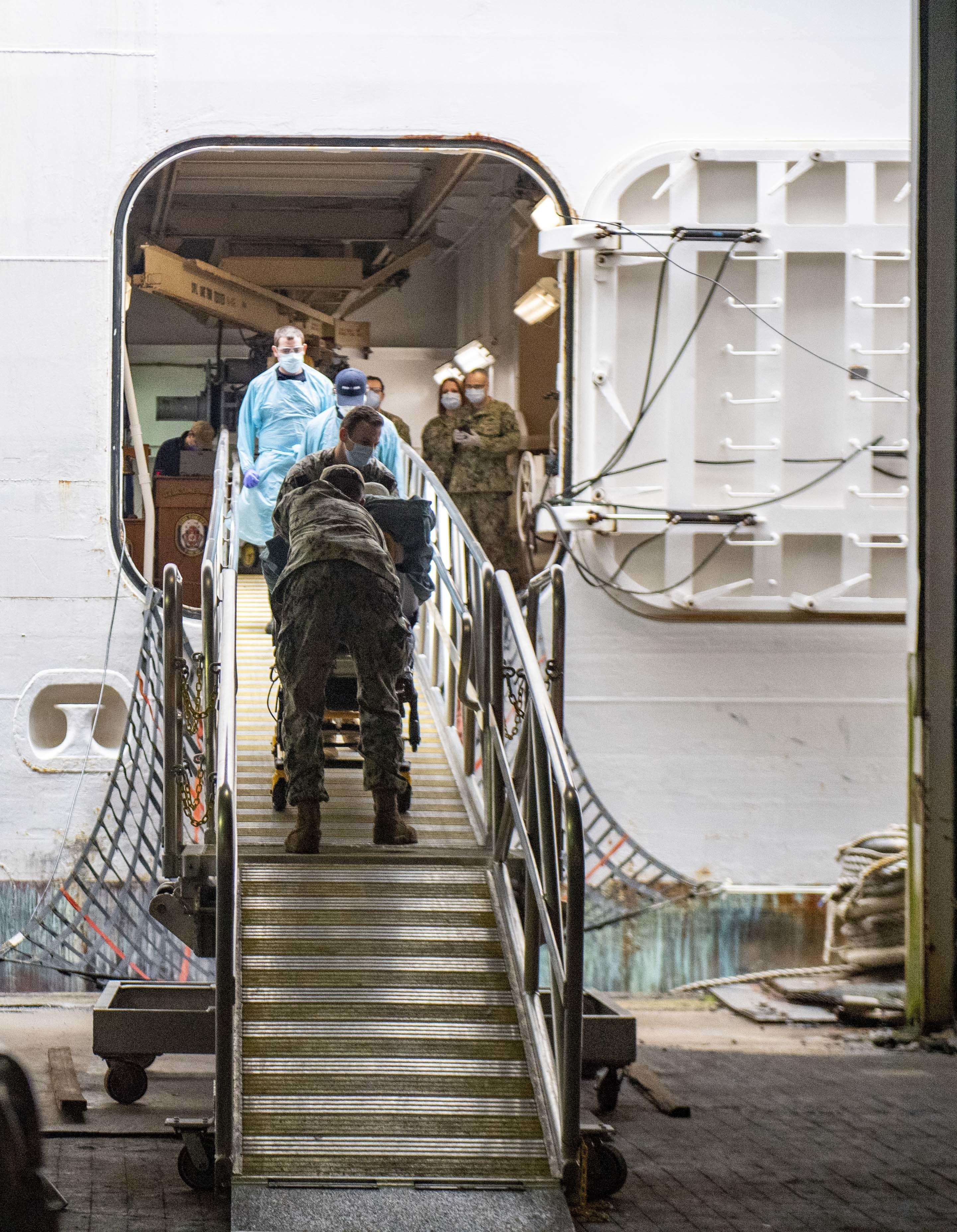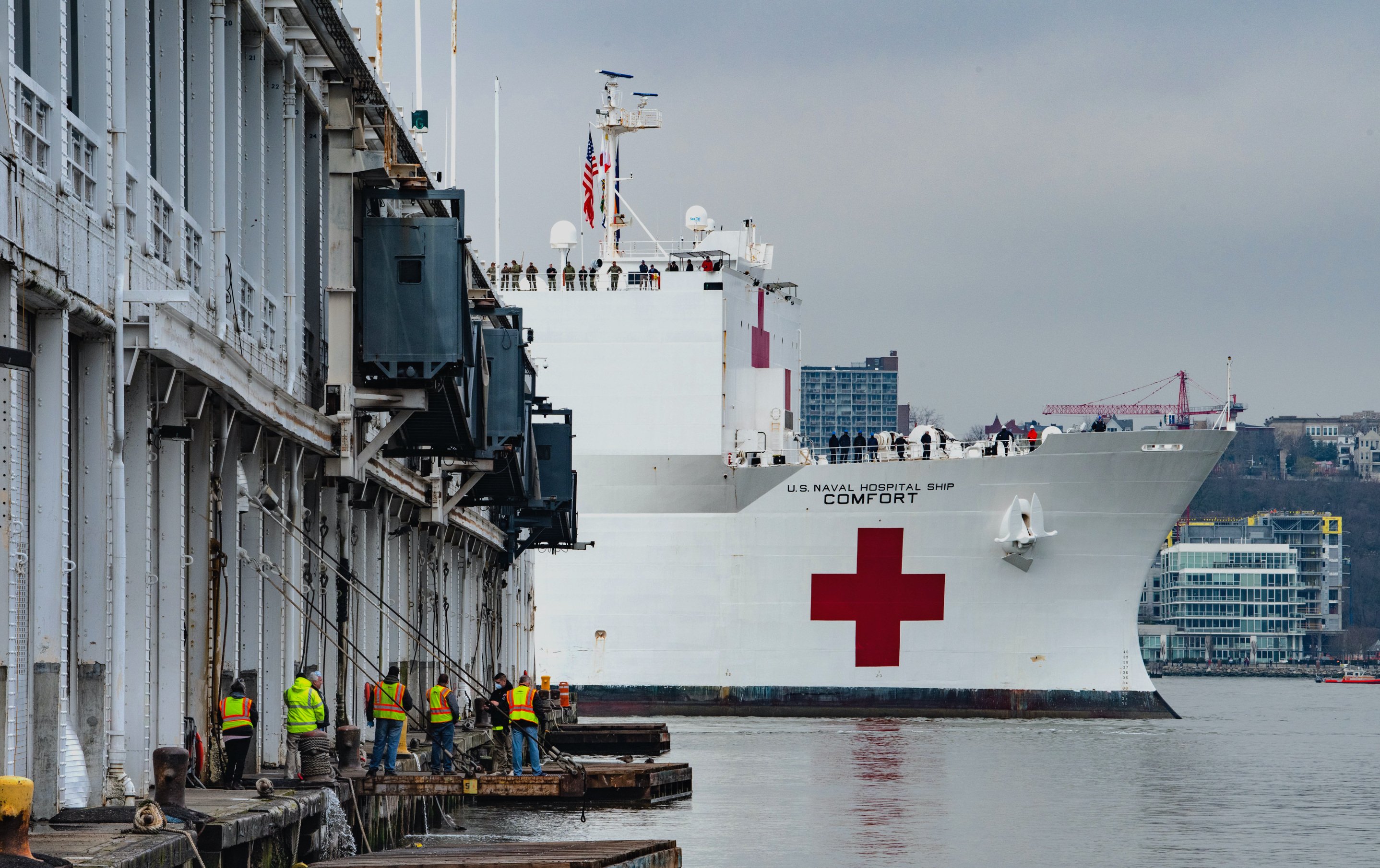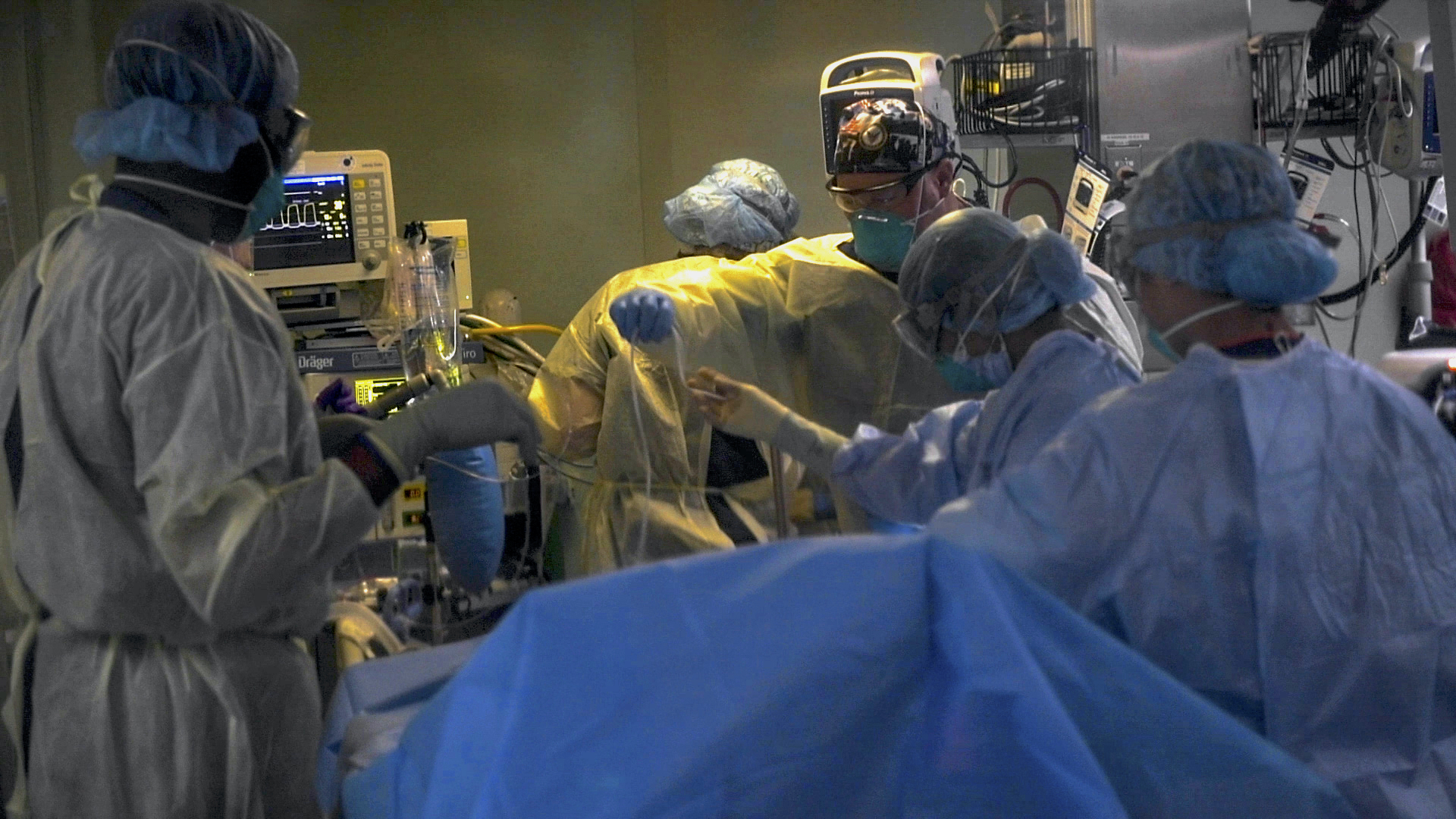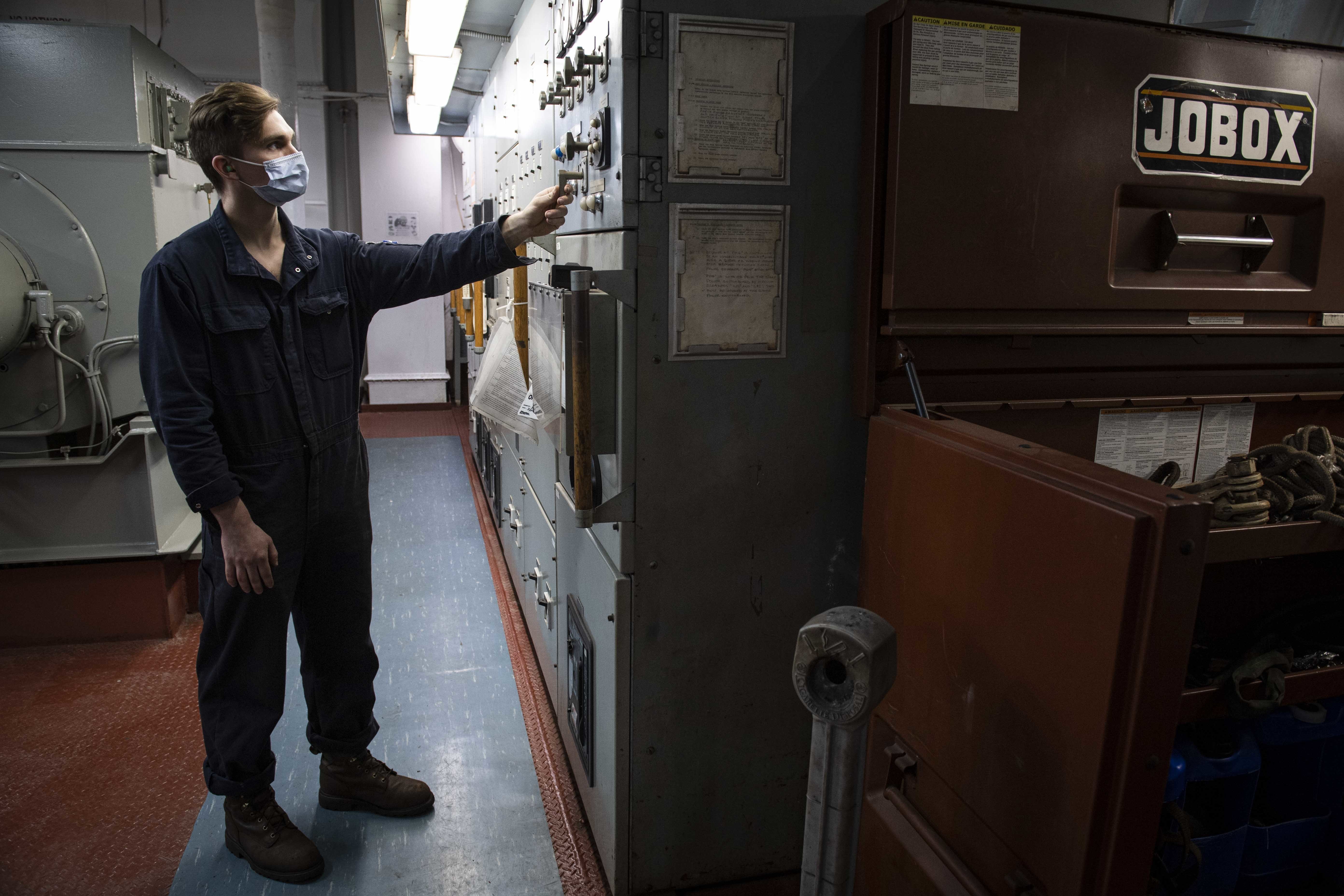
After a nearly-month-long mission helping New York in the COVID-19 pandemic fight, hospital ship USNS Comfort (T-AH-20) will leave its temporary berth – likely for its Virginia homeport – and prepare for a possible assignment elsewhere.
Medical teams aboard Comfort, which last month quickly activated and deployed from Norfolk, Va., treated a total of 182 patients over a three-and-a-half week period in support of the domestic coronavirus mission intended to ease pressures on local hospitals. That was far fewer than public assumptions and expectations for the floating 1,000-bed hospital, which arrived just as the New York City region saw surges in infections and patients requiring intensive-care-level treatment.
But the care rendered to those 182 patients isn’t irrelevant, a senior officer told USNI News.
“In a perfect world, we wouldn’t have put a single person aboard this ship,” said Capt. Joseph O’Brien, who commands Norfolk-based Amphibious Squadron 6 and is commander of Task Force New York City supporting the COVID-19 mission. “We would have pulled up here, the hospitals would have had excess capacity and not needed us – and I told the crew that from the very beginning. Our job has been to take the pressure off the hospitals.”
Local officials initially estimated that medical facilities would be slammed by COVID-19-infected patients and staffs on top of the normal caseloads they typically handle, further straining their resources such as limited ventilators and intensive care unit beds. But while some hospitals got inundated, stay-at-home and social-distancing orders resulted in many hospitals seeing fewer patients, and the result was less demand from New York and New Jersey to have patients transferred to Comfort for care.
“So 182 might not sound like a whole lot of people – and it’s not – but it was 182 people that got high-quality care here, and it was 182 beds that got freed up out in the city,” O’Brien said by phone from the ship Friday.
The last patient arrived on Comfort on April 21, the same day President Donald Trump announced the ship would end its mission in New York following a discussion with New York Gov. Andrew Cuomo. As of Friday afternoon, 31 patients remained on the ship, with about two-thirds of them in the ICU, and through the weekend the Navy worked with regional hospitals to transfer those remaining patients off the ship.
“We’re working with the state and the city for placement of the patients in equivalent medical facilities out in town as we start to wind down the mission here,” O’Brien said.

Comfort, which arrived in New York Harbor to much fanfare on March 30, has been part of the military’s support to the region that includes treatment of 1,100 or so at the military-supported federal medical station set up at the Jacob Javits Convention Center in Manhattan. Combined, “we made a pretty significant impact,” O’Brien said. “But the reality is the hospitals were able to double the number of ICU beds almost in the time that we were here.”
“We had the extra capacity – if it was needed – and fortunately it wasn’t needed,” he added. “So I think that is a win.”
The 1,100-member Medical Treatment Facility that embarked aboard Comfort for the mission was drawn from East Coast naval hospitals, clinics and other commands and includes reservists.
“The numbers were pretty much irrelevant to us. It was about the patient in front of us, and providing the greatest possible care,” Capt. Patrick Amersbach, the MTF commander, told USNI News. Medical teams “didn’t worry about how many were coming aboard or what was going to happen later on down the road.”
“Their focus really was taking care of that patient – regardless if it’s 100 or 10 or one – to ensure that they got the highest quality of care possible,” Amersbach said.
Medical teams aboard Comfort treated a much different group of patients with needs different than the surgical and trauma-focused care they would provide in a major combat operation, which is the hospital ship’s primary mission. Instead, it reflected the broader type of care provided in the ship’s secondary and tertiary missions of humanitarian aid and disaster relief.
“Coming to New York is slightly different, because we are not taking care of a younger population with a traumatic injury or … or a gunshot or bullet wound,” Amersbach said. “We’re taking care of mostly an older population who had tested COVID-positive or tested for illnesses or other medical conditions that required ICU-level” care.
When Comfort left Norfolk for New York, “we had a full complement of internal medicine specialists and critical care specialists, and we were able to augment that when we got up here as well to make sure we had the right numbers in addition to the right skill sets,” he said. “We had everything from urology, nephrology, pulmonology, critical care, hematology, oncology – so we had the full spectrum of specialists you’d find in a hospital in a city that were here to provide care to patients.”

Patients’ medical needs were varied and mirrored that of New York City and state as a whole, as well as New Jersey, he said. Some patients suffered with complex, COVID-caused pneumonia or multi-system organ failure. Others required dialysis or respiratory services. Some required surgical procedures. “So the full spectrum of care … is being provided on ship,” he added.
Comfort, a converted oil tanker with a 12 operating rooms, is kept in a reduced operating status and maintains large supplies, including personal protective equipment (PPE), when not deployed. Once underway, “we’ve had a very robust and capable logistics system with five personnel to ensure that we had everything that we needed while we are here,” Amersbach said.
While the ship’s mission was to treat and care for non-COVID-19-infected patients, a few days into the mission the ship’s internal spaces were reconfigured to create separate COVID-negative and COVID-positive sections. “We were fortunate in respect that we have multiple wards and multiple ICUs which allowed us to separate and address those different populations,” he said.
Additional environmental controls across the ship limited the number of personnel that would be in and out of the ship’s hospital area – compared to berthing, engineering spaces and other areas – to protect patients, medical personnel and the ship’s crew of civilian mariner from cross-contamination.
“Controlling that flow made a big difference in potentially exposing personnel to the virus, in addition to following [Centers for Disease Control and Prevention] and [Defense Department] guidelines for the use of PPE aboard the ship, in its entirety,” Amersbach added, and “not just in the care areas but everybody is wearing a mask.”

Medical staff, including doctors, nurses and technicians directly were working with patients, were moved off Comfort to a local hotel. That provided more space in the ship’s berthing and galley areas and “maximized our ability to socially distance from each other and to minimize cross exposure or potential exposure to the virus,” Amersbach said. Everyone who came aboard was screened per DoD guidelines, and all patients were tested, which “helped us confirm exactly where they needed to go aboard the ship to avoid that cross-contamination.”
Several personnel aboard Comfort had tested positive for the virus and were isolated aboard the ship. None had had contact with patients, the Navy reported. O’Brien said that, after those positive results, he spoke on the ship’s 1MC “and let the crew know, mainly because we don’t want them to be afraid of it.”
“We were early adopters in wearing the PPE,” he said. “We did a lot of risk-mitigation in how we set the hospital up. We did the social distancing and CDC guidelines. So we had everything in place to make sure we were able to manage it – and we had the benefit of having a hospital on board. So we were able to isolate the crew members and treat them just like any of the other COVID-positive patients that we had and get them through it. Fortunately they all had just very mild symptoms and get them back up and get them back working and back in the fight.”
“Everybody aboard this ship left somebody behind in a time of need, a national crisis,” Amersbach said. “Allowing that to occur with as little drama as possible is a testament to the strength of those still in the Norfolk, Newport News and Portsmouth area and of course our reservists and their families as well.”





